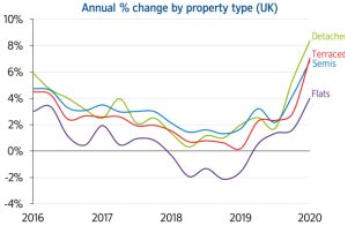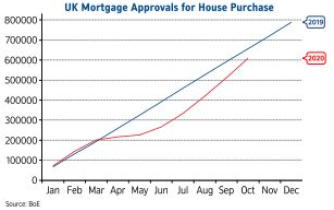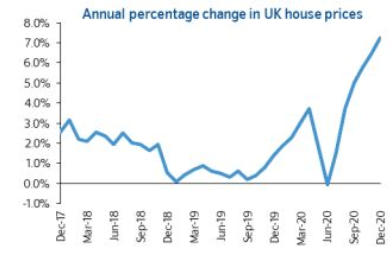
The Financial Group
We simplify all those essential financial decisions

’Annual house price growth rose to a six-year high of 7.3% at the end
of 2020’ according to the latest Nationwide house price survey.
•
Prices up 0.8% month-on-month, after taking account of seasonal factors
•
All regions saw a pick up in house price growth rates in Q4, with E.Midlands the strongest region
Headlines
Dec 20
Nov 20
Monthly Index*
462.0
458.2
Monthly Change*
0.8%
0.9%
Annual Change
7.3%
6.5%
Average Price (not seasonally adjusted)
£230,920
£229,721
* Seasonally adjusted figure (note that monthly % changes are revised when seasonal adjustment factors are re-estimated)
Commenting
on
the
figures,
Robert
Gardner,
Nationwide's
Chief
Economist,
said:
“Annual
house
price
growth
accelerated
further
in
December,
reaching
a
six
year
high
of
7.3%,
up
from
6.5%
in
the
previous
month.
Prices
rose
by
0.8%
month-on-month,
after
taking
account
of
seasonal
effects,
following
a
0.9%
rise
in
November.
House prices ended the year 5.3% above the level prevailing in March, when the pandemic struck the UK.
“The
resilience
seen
in
recent
quarters
seemed
unlikely
at
the
start
of
the
pandemic.
Indeed,
housing
market
activity
almost
ground
to
a
complete
halt
during
the
first
lockdown
as
the
wider
economy
shrank
by
an
unprecedented
26%.
But,
since
then,
housing
demand
has
been
buoyed
by
a
raft
of
policy
measures
and
changing preferences in the wake of the pandemic.
“The
furlough
and
Self
Employment
Income
Support
schemes
provided
vital
support
for
the
labour
market,
while
a
host
of
measures
helped
to
keep
down
the
cost
of
borrowing
and
keep
the
supply
of
credit
flowing.
The
stamp
duty
holiday
also
stimulated
housing
demand,
by
bringing
forward
peoples’
home-moving
plans.
Lenders
also
responded
by
offering
payment
holidays
to
borrowers
impacted
by
the
pandemic,
helping
people
stay
in
their
homes rather than potentially being forced to sell.
“The
pandemic
itself
also
boosted
activity,
as
life
in
lockdown
and
changes
to
working
patterns
led
many
to
re-
evaluate
their
housing
needs.
Our
research
earlier
this
year
indicated
increased
demand
for
less
densely
populated
locations
and
different
property
types.
This
helps
to
explain
why
detached
properties
have
seen
greater
price
gains in recent quarters, while flats have underperformed (as illustrated in the 1st chart above).
“Housing
market
conditions
have
remained
robust
in
recent
months,
even
as
the
wider
economic
recovery
lost
momentum
and
the
UK
economy
faced
the
prospect
of
further
lockdowns
and
continued
uncertainty
about
the
UK’s
future
international
trading
relationships.
The
number
of
mortgages
approved
for
house
purchase
each
month
reached
their
highest
level
for
a
decade
in
October,
nearly
50%
above
the
monthly
average
recorded
in
2019.
Indeed,
by
the
end
of
October,
the
total
number
of
mortgages
approved
for
house
purchase
in
2020
was
only
7%
below
the
total
recorded
over
the
same
period
in
2019
(as
shown
in in the chart right).
Where next? “The outlook remains highly uncertain. Much will depend on how the pandemic and the
measures to contain it evolve as well as the efficacy of policy measures implemented to limit the damage to the
wider economy. Behavioural shifts as a result of Covid-19 may continue to provide support for housing market
activity, while the stamp duty holiday will continue to provide a near-term boost by bringing forward home
moves. However, housing market activity is likely to slow in the coming quarters, perhaps sharply, if the labour
market weakens as most analysts expect, especially once the stamp duty holiday expires at the end of March.
Annual price growth picks up across all regions in Q4 “Annual house price growth increased in all
regions in Q4 (October, November & December) compared with Q3 (July, August & September). The East
Midlands was the strongest region in 2020, with prices up 8.6% over the year.
“England saw the highest growth amongst the home nations in 2020, with prices up 6.9%. This is a sharp
contrast with 2019 when England was the weakest nation with minimal annual growth.
“All regions in England saw prices rise over the year, within a fairly narrow range of 5% to 9%. The Outer South
East region, which includes cities such as Brighton, Southampton and Oxford, saw a significant change in
fortunes – prices were up 8% in 2020, following a 1% decline in 2019. The neighbouring Outer Metropolitan
region, which includes places such as Slough, Guildford, Crawley and Chelmsford, was the weakest performing
English region, but still saw prices rise by 5.6% over the year. Meanwhile, London saw a 6.2% increase, with
average prices reaching their highest ever at £486,562. We also saw a marked rise in annual price growth in
Northern England in the fourth quarter, in particular in the North West and Yorkshire & Humberside, where
annual price growth increased to 8.0% and 7.7%, respectively.
“Turning to the other home nations, Wales saw prices rise by 6.6%, whilst Northern Ireland saw a 5.9%
increase. Scotland saw the weakest growth of the home nations, with prices only up 3.2% in 2020. This
contrasts with 2019, where Scotland ended the year on top, with growth of 2.8%.“
House Price Statistics

THE HOUSING & MORTGAGE MARKET January 2021


Note: Indices and average prices are produced using Nationwide's
updated mix adjusted House Price Methodology, which was introduced with effect from the first quarter of 1995. The data is drawn from
Nationwide’s house purchase mortgage lending at the post survey approvals stage. Price indices are seasonally adjusted using the US Bureau
of the Census X12 method. Currently the calculations are based on a monthly data series starting from January 1991. Figures are
recalculated each month which may result in revisions to historical data.






- In the News
- The Housing Market
- The Education Section
- Income Drawdown
- ISAs
- Lisa & Help to Buy ISA
- Risk v Return
- Stamp Duty Land Tax
- Archive
- Oct 2011 State Pensions
- Nov 2011 Structured Products
- Dec 2011 Pound Cost Averaging
- Jan 2012 Trusts
- Feb 2012 ASU
- Mar 2012
- Apr 2012 House Surveys
- May 2012 Options at retirement
- Jun 2012 IHT
- July 2012 FSCS
- Aug 21012 Index
- Sep 2012 EU Gender Directive & I minus E
- Oct 2012 Interest Only mortgages
- Nov 2012 NEST
- Feb 2013 APR
- Apr 2013
- May 2013 Investing in Funds pt1
- June 2013 Investing in Funds pt2
- July 2014 New ISAs









